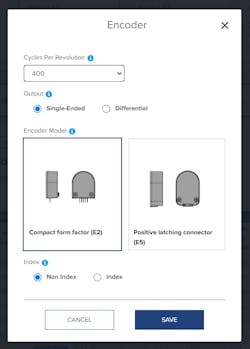Thomson Industries Offers Upgraded Actuator Selection Tool
The upgraded selector tool automates the selection process for stepper motor linear actuators (SMLAs) based on specific machine design requirements. Users can define motor frame size and screw configurations and select the encoder suited for their needs. The tool allows for the selection of features such as encoder cycles per revolution (CPR), non-index or index feedback control, and single-ended or deferential output.
Key features of the tool include:
Integrated encoder options. Users can specify a range of encoder types directly within the interface.
Real-time updates. As selections are made, product specifications are automatically updated, allowing users to visualize changes immediately.
Instant CAD model downloads. Users can download fully integrated CAD models after selecting the desired components.
Simplified workflow. The tool combines selection and purchasing steps into a single process, including integrated pricing information.
Previously, adding an encoder required additional steps such as contacting customer support or waiting for customized solutions. With the update, all necessary specifications are available within the tool.
Machine Design had a few more questions about the selector tool, so we reached out to Lindsey Brimage, Sr., product manager for screws at Thomson.
Editor’s note: The following Q&A may be edited for style or clarity.
Machine Design: What design challenges does this addition aim to address, and how does it facilitate problem-solving for Machine Design’s audience of design and mechanical engineers?
Lindsey Brimage: The SMLA product selector empowers users to quickly and easily select the right encoder to pair with any Thomson stepper motor linear actuator configuration (MLS, MLN or MLA). Encoders allow users to monitor speed, direction, distance and position for their linear motion applications. These benefits can be easily realized with the simple integration of encoders, which after the customer selection, are seamlessly pre-assembled onto the rear of motors, translate rotary motion into a digital signal to deliver real-time feedback information.
MD: Can you explain the user experience and interface of the tool as it pertains to MD’s audience—what makes it intuitive or user-friendly?
LB: The user experience flows intuitively through basic application details such as the customer preferred SMLA configurations and load requirements. From those selections, customers will be provided a few standard SMLA configurations to which they can add an encoder. Instead of having to source the encoder separately or search through catalogs for specifications, the SMLA product selector tool requests the customers required cycles per revolution, output and proposes the encoder models that will fit the requirements.
MD: Can you provide insights into the R&D process behind this update, and were any innovations discovered along the way?
LB: VOC (voice of customer)! We understand that our customers are looking to find product solutions quickly and are looking for more packaged solutions rather than individual components. We have taken both things into account and created an intuitive tool to allow customers to size, select and purchase a package lead screw, stepper motor and encoder solution.
MD: Can you talk about any use cases or applications that our audience can consider in relation to this tool?
LB: We serve a wide range of applications and verticals from medical to factory robotics. Some examples are pipetting in lab automation, plate vertical positing in test equipment, monitor tilting, XY-stages, 3D printing, fluid pumping, robotic grippers and horizontal positioning.



